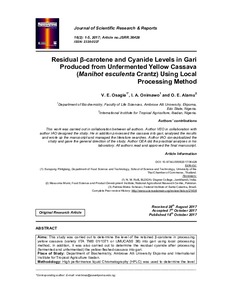| dc.contributor.author | Osagie, V.E. |
| dc.contributor.author | Onimawo, I.A. |
| dc.contributor.author | Alamu, E.O. |
| dc.date.accessioned | 2019-12-04T11:30:09Z |
| dc.date.available | 2019-12-04T11:30:09Z |
| dc.date.issued | 2017 |
| dc.identifier.citation | Osagie, V.E., Onimawo, I.A. & Alamu, O.E. (2017). Residual β-carotene and cyanide levels in gari produced from unfermented yellow cassava (Manihot esculenta Crantz) using local processing method. Journal of Scientific Research & Reports, 16(2), 1-5. |
| dc.identifier.issn | 2320-0227 |
| dc.identifier.uri | https://hdl.handle.net/20.500.12478/5208 |
| dc.description | Published online: 18 Oct 2017 |
| dc.description.abstract | Aims: This study was carried out to determine the level of the retained β-carotene in processing yellow cassava (variety IITA TMS 01/1371 or UMUCASS 38) into gari using local processing method, in addition, it was also carried out to determine the residual cyanide after processing (fermented and unfermented) the yellow-fleshed cassava into gari. Place of Study: Department of Biochemistry, Ambrose Alli University Ekpoma and International Institute for Tropical Agriculture Ibadan.
Methodology: High performance liquid Chromatography (HPLC) was used to determine the level of β-carotene in gari produced from fermented and unfermented yellow cassava while the cyanide level was determined by an automated Enzymic method.
Results and Discussion: It showed that the gari produced from fermented yellow cassava had a higher level of β-carotene depending on the number of days of fermentation compared with the gari from unfermented yellow cassava. The gari produced from unfermented cassava had the least content of β-carotene (8.076±0.311 ug/g) during the first week of storage compared with those produced from fermented cassava (10.600±0.470 - 20.610±0.098 ug/g). There was a reduction in the β-carotene contents in all groups during the 5week storage period. The rate of loss of β-carotene over a five week period showed that the gari from unfermented cassava had the least rate of loss (0.885 ug/week) compared with the gari from fermented cassava over the same period (0.955-2.447 ug/week). However the level of Hydrogen cyanide (HCN) retained was more in the gari from unfermented yellow cassava (3.160±0.006 mg/100 g) compared with the gari from fermented cassava (0.470±0.046-1.423±0.006 mg/100 g).
Conclusion: On the basis of the result, it is suggested that yellow cassava should be fermented before being roasted into gari and adequate method of storage be adopted to reduce loss of β-carotene while in storage. |
| dc.format.extent | 1-5 |
| dc.language.iso | en |
| dc.rights | CC-BY-4.0 |
| dc.subject | Carotenes |
| dc.subject | Cyanides |
| dc.subject | Garri |
| dc.subject | Cassava |
| dc.subject | Nigeria |
| dc.title | Residual β-carotene and cyanide levels in gari produced from unfermented yellow cassava (Manihot esculenta Crantz) using local processing method |
| dc.type | Journal Article |
| dc.description.version | Peer Review |
| cg.contributor.crp | Agriculture for Nutrition and Health |
| cg.contributor.affiliation | Ambrose Alli University |
| cg.contributor.affiliation | International Institute of Tropical Agriculture |
| cg.coverage.region | Africa |
| cg.coverage.region | West Africa |
| cg.coverage.country | Nigeria |
| cg.creator.identifier | Alamu Emmanuel Oladeji: 0000-0001-6263-1359 |
| cg.researchtheme | NUTRITION & HUMAN HEALTH |
| cg.authorship.types | CGIAR and developing country institute |
| cg.iitasubject | Cassava |
| cg.iitasubject | Nutrition |
| cg.journal | Journal of Scientific Research & Reports |
| cg.howpublished | Formally Published |
| cg.accessibilitystatus | Open Access |
| local.dspaceid | 102874 |
| cg.targetaudience | Scientists |
| cg.identifier.doi | http://dx.doi.org/10.9734/jsrr/2017/36428 |

